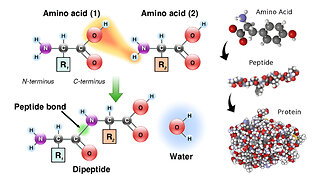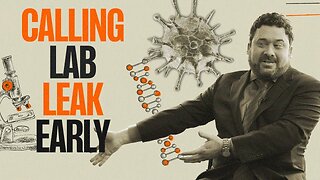Acids and Bases: Brønsted–Lowry, Arrhenius, and Lewis Models
In this video I provide an overview of acids and bases, their 3 different theories, and provide a pH chart of household items. The 3 different models or theories of acids and bases are all either a superset or subset of each other. The Lewis model is the most general and states that an acid accepts an electron pair (via a covalent bond) while a base donates an electron pair. The Brønsted–Lowry model is a subset of the Lewis model and states that an acid gives protons while a base takes protons. The Arrhenius model is a subset of the Brønsted–Lowry and states that in aqueous solutions (where water is the solvent) acids give the hydronium ion (H3O+) while bases give the hydroxide ion (OH-).
The acidity or basicity of aqueous solutions is measured on a pH scale (short for "power or potential of hydrogen") and is an inverse logarithmic chart. The higher the concentration of hydronium ions, the lower the pH and hence more acidic the solution. The lower the concentration of hydronium ions, the higher the pH and hence more basic the solution is. Note that the pH scale is logarithmic, thus and increase or decrease of 1 pH means a 10 times increase or decrease in the concentration of hydronium ions. Pure water is considered neutral and has a pH of 7. Lemon juice is acid and has about a 2 pH, whereas household bleach is very basic with a pH close to 13.
I also briefly cover surfactants, which are substances that lower the surface tension between liquids; hence are typically used as soaps or detergents.
Time stamps:
- Acids donate protons or form covalent bond with electron pairs: 0:00
- 3 definitions for Bases: 1:43
- Acid Base Reaction theories as superset and subset models: 2:31
- H+ is short for the hydronium ion: 3:06
- Acids become more negative, bases become more positive: 4:29
- Arrhenius theory by Svante Arrhenius in 1984: 4:35
- Bronsted-Lowry theory by Johannes Nicolaus Bronsted and Thomas Martin Lowry proposed in 1923 and formalized in 1938: 5:44
- Lewis theory by Gilbert N. Lewis in 1923: 6:35
- Bronsted-Lowry acid-base and conjugates equilibrium expression: 6:59
- Chemical reaction and equilibrium: 10:10
- pH or Potential of hydrogen: 10:57
- pH logarithmic chart of household items: 13:09
- Surfactants lower surface tension between two liquids: 14:54
- Periodic table of elements: 16:38
- Acid strength: Strong vs Weak acid: 17:48
Full video below:
- #MESScience 3: Overview of Biology: https://youtu.be/WX_qzT0nZFY
- HIVE video notes: https://peakd.com/hive-128780/@mes/messcience-3-overview-of-biology
- Video sections playlist: https://www.youtube.com/playlist?list=PLai3U8-WIK0FYO6bxFbBAtVJ9sDOJnH72
- #MESScience playlist: https://www.youtube.com/playlist?list=PLai3U8-WIK0FjJpwnxwdrOR7L8Ul8VZoZ .
------------------------------------------------------
Become a MES Super Fan! https://www.youtube.com/channel/UCUUBq1GPBvvGNz7dpgO14Ow/join
DONATE! ʕ •ᴥ•ʔ https://mes.fm/donate
SUBSCRIBE via EMAIL: https://mes.fm/subscribe
MES Links: https://mes.fm/links
MES Truth: https://mes.fm/truth
Official Website: https://MES.fm
Hive: https://peakd.com/@mes
Email me: contact@mes.fm
Free Calculators: https://mes.fm/calculators
BMI Calculator: https://bmicalculator.mes.fm
Grade Calculator: https://gradecalculator.mes.fm
Mortgage Calculator: https://mortgagecalculator.mes.fm
Percentage Calculator: https://percentagecalculator.mes.fm
Free Online Tools: https://mes.fm/tools
iPhone and Android Apps: https://mes.fm/mobile-apps
-
 16:34
16:34
Math Easy Solutions
9 days ago $0.10 earnedOrganic Compounds: Amino Acids, Peptides, and Proteins
1451 -
 1:26:52
1:26:52
Real Coffee With Scott Adams
10 hours agoEpisode 2478 CWSA 05/18/24
62.8K53 -
 6:10
6:10
Adam Does Movies
22 hours ago $0.95 earnedThe Strangers: Chapter 1 Movie Review - I Wanted Them Dead
60K9 -
 1:36:18
1:36:18
Squaring The Circle w/ Randall Carlson
1 day ago#005 Untangling The Propaganda Around Twisters
72.9K43 -
 13:31
13:31
Space Ice
1 day agoMovie "Shoot 'Em Up" Is So Good You'll Realize How Worthless You Truly Are - Best Movie Ever
62.5K32 -
 16:01
16:01
Bearing
1 day agoTikTok has Reached NUCLEAR Levels of CRINGE
58.7K42 -
 5:46
5:46
Chris Jericho
1 day agoTalk Is Jericho Highlight: Renny Harlin Talks The Strangers & Nightmare On Elm Street 4
47.6K4 -
 17:05
17:05
DEADBUGsays
1 day agoThe Beast Of Manchester
31.5K7 -
 4:54
4:54
ErmzPlays
14 hours ago $0.64 earnedHalo Composer Sets Gaming Industry ON FIRE By Coming Out As Republican
27.9K11 -
 11:15
11:15
Good Kid Productions
1 day agoCalling Lab Leak Early with the Washington Post's Josh Rogin (convo)
25K10